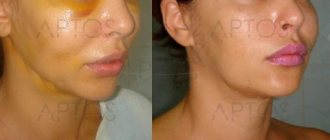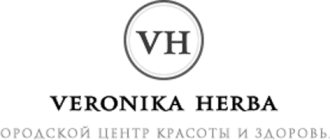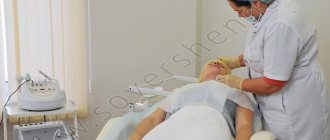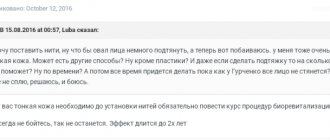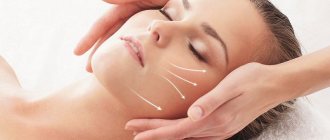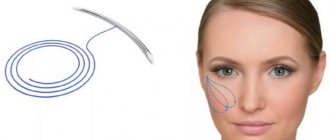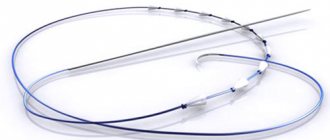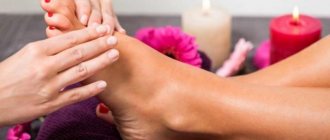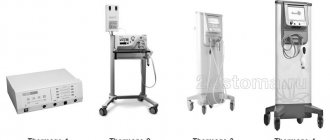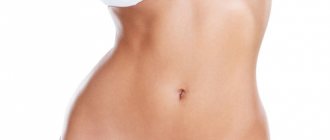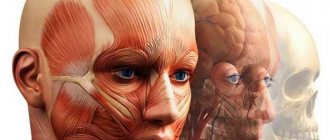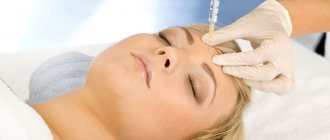In this article we will talk about a fairly new rejuvenation technique, or rather, a new version of the popular method. This technique is called “PDO Treadlifting,” which translated means supporting or lifting the face with the help of cosmetic threads. Now its Asian version, developed in South Korea, is gaining popularity, when special medical threads made from the material Polydioxanone (PDO) are used for facial rejuvenation. What is the peculiarity of this cosmetic technique, let's figure it out
What are PDO threads - general information
Since the general name of this procedure, unlike mesotherapy, has not yet been established, you can come across such names as “Ultra V lifting”, “Lifting with 3D threads”. These are the same commercial names for an advanced cosmetic technology that uses thin medical threads made of polydioxanone (PDO), which have long been widely used in surgery, including facial plastic surgery, to stimulate the growth of skin tissue.
As a result, new collagen was quickly created in the skin, which produced a rejuvenating effect and smoothed the skin of the face. During the procedure, sagging skin is stretched, a so-called sculpted 'V-shaped' face is created, and most importantly, a visible rejuvenating effect is quickly achieved.
Composition of PDO threads
PDO threads are made from Polydioxanone (PDO), a synthetic polymer, and are ultra-thin, only 0.12 mm thick. Polydioxanone (PDO) introduced under the skin disintegrates within 4-8 months as a result of hydrolysis, without going into terms, into water and carbon dioxide.
Question to the expert: How to choose the best threads for thread lifting
Threads are a great invention for improving the quality and lifting of skin!
But the method can show excellent results only in the hands of an experienced and competent doctor. Our experts, specialists who widely and successfully use thread techniques, tell us how to choose threads for thread lifting...
Dorina Donich
Doctor of Medicine, specialist in the field of bioreparative and anti-age medicine; scientific director of A Swiss Group,
Before choosing threads for use in our face and body programs - LuxeFace and LuxeBody - we carefully studied the various materials offered by the modern aesthetic market and settled on two types of threads - polydioxanone (PDO) and polycaprolactone. These threads have undergone serious clinical trials and have proven their effectiveness and safety. Thus, polydioxanone threads trigger bioreparation and regeneration processes in tissues, enhance local microcirculation, provide lifting, rejuvenate and whiten the skin.
The threads have a special design: different thicknesses and surface relief, can be with half-cones and notches, smooth, velor or spiral.
Threads of a specific type are selected individually for each patient. We inject thin threads of polydioxanone directly into the skin structures or into the subcutaneous fat layer. They are embedded in tissues, triggering local regeneration processes, improving the appearance and quality of the skin. Polycaprolactone threads are inserted more deeply - sometimes at the muscle level or under the fascia - to provide a long-lasting tightening effect and mechanical tissue support. The technique we have developed involves placing threads according to a certain pattern, as a result of which “bridges” of collagen and elastin are formed between the threads, which compact and contract the tissue, creating an effect close to the result of plastic surgery. The threads are inserted using cannulas, which makes the procedure less traumatic.
The result of thread lifting is layer-by-layer reduction and tissue rejuvenation. On the face, we can remove jowls, raise cheekbones, cheeks and corners of the mouth, eliminate nasolabial folds, level out the nasolacrimal groove, reduce the double chin, work with crow’s feet, lift eyebrows and “open” the eyes, smooth the forehead, tighten the neck and remove there are no wrinkles... As for the body, here after a thread lift we observe thickening and lifting of the skin, smoothing out the relief. The effect allows you to tighten the buttocks, chest, abdomen, and décolleté area.
Regarding the duration of the result: polydioxanone remains in the tissue for 6–12 months, depending on the thickness of the threads. Polycaprolactone threads last 24–36 months. The duration of the resulting lifting depends on the initial condition of the tissues: the worse their moisture, nutrition and blood supply, the more thread lifting procedures (with an interval of six months) need to be done to achieve a lasting result.”
Natalia Rogova
cosmetologist at the Sensavi Beauty Institute
For thread lifting, we use polydioxanone mesothreads Lead Fine Lift: Double Lift - they are excellent for tightening and strengthening soft tissues. It is a skin-biocompatible, completely absorbable suture material. As you know, with age, the number of collagen fibers in the skin decreases, it becomes atonic, signs of sagging appear... The thread lifting procedure helps to tighten the skin by stimulating the production of new collagen around the introduced thread: the thread will dissolve, but its own strong collagen framework will remain! And also perform a tightening: for this, the threads have multidirectional notches that allow you to tighten and fix the tissue in a new position.
The result of the effect is immediate, and after a month or two - as the synthesis of new collagen increases - it becomes even more pronounced. We usually carry out a course of such procedures, the intervals between them depend on the individual characteristics of the patient. Thread lifting is not indicated for those who have significant gravitational ptosis or excess subcutaneous fat. In other cases, it can be used to achieve noticeable tightening and rejuvenation.
Thread technologies combine well with hardware techniques. Thus, an excellent effect can be achieved by using Ulthera ultrasonic lifting followed by the introduction of threads. First, we work with focused ultrasound at the deep level of SMAS - we strengthen the muscular-aponeurotic system of the face (when this technology did not exist, only surgeons could influence SMAS). And a month later we “sew” the threads at the level of the skin and subcutaneous fat. Thus, a pronounced and stable anti-aging result is achieved.”
Alina Katorova
cosmetologist, head of the “Figure Correction Clinic”
Korean-made polydioxanone threads Lead Fine Lift have proven themselves to be excellent both for lifting and for solving other aesthetic problems. For pronounced tissue tightening, threads with notches are used, which are inserted with cannulas into the subcutaneous fat layer. Spiral mesothreads are used to locally strengthen and tighten the skin. And threads with a smooth structure are good for reinforcing the skin above the upper lip (purse-string wrinkles) and the periorbital area.
If we talk about the number of threads, then, for example, from ten to twenty thin mesothreads are introduced into the tissue of the area around the eyes and the same number of spiral ones are introduced into the middle zone of the face. To lift the oval of the face, four to eight dense threads with notches are required, to correct the eyebrows - from four to six threads. Since many patients have asymmetry, the number of threads to be inserted on different sides of the face may vary.
The result obtained lasts for at least a year, and often lasts up to two years - it all depends on the individual characteristics of the person and the initial state of the tissues: someone at 45 looks like 60, and someone at 50 cannot look more than 40. The nature of age-related changes also plays a role their role: with the finely wrinkled type of aging, threads will not be very effective, but the deformation type characteristic of Slavs lends itself well to thread correction.
If indicated, threads can be combined with contouring. These techniques complement each other’s capabilities: fillers fill the lack of volume and remove tissue recesses, and threads strengthen and tighten the skin and facial contours. As a rule, threads with notches are placed first, and then the volume deficit is corrected with fillers. Thanks to thread lifting, subsequent filler consumption is significantly reduced. This not only saves the patient money, but also avoids overloading the face with hyaluronic acid. The result of this combination of techniques is very natural - a non-specialist will not even notice that some kind of intervention has been carried out. To smooth out facial wrinkles in the forehead and corners of the eyes, it makes sense to combine the introduction of mesothreads with botulinum toxin injections.”
Elena Kondrasheva
cosmetologist, chief physician of the Helen Baden Youth Clinic
I practically never use the usual mesothreads that most cosmetologists work with. They simply lie in the skin or subcutaneous fat, are not fixed in any way and do not provide lifting. This is thread biorevitalization, nothing more. Real lifting - moving tissue to a higher position - is only possible with the introduction of denser threads with notches and a fixed attachment point
in the head area, where there is no tissue movement (for example, in the area of the temporal fascia). If you place the thread within the soft tissues, say, from the cheekbone to the angle of the lower jaw, it will simply break during intense facial movements.
For deep lifting, ligatures are used - special dense threads that allow you to move and fix tissue in a new position. Typically these are polydioxanone threads with a long resorption period. They are fundamentally different from the widely used mesothreads: they have b o
greater thickness, specially arranged multi-directional notches and a rigid fixation point. The technique of their introduction involves creating a loop and “suspending” ptotic soft tissue at the level of the superficial muscular aponeurotic layer (SMAS). For strong fixation, the threads are attached to stable facial structures, such as the temporal fascia, mastoid process, and periosteum. Thus, ligature lifting provides controlled redistribution and tension of tissues, thereby achieving a pronounced and long-term tightening effect. Threads are selected strictly individually. To form a clear oval face, it is necessary to simultaneously carry out a vertical and horizontal lift. With age-related changes, tissues shift not only downwards, but also towards the center - towards the nose, towards the bridge of the nose, therefore nasolabial folds, tear grooves appear, and cheekbones become flattened. With ligature lifting, we carry out mechanical actions to return the tissue to its original place.
To tighten the face of a patient aged 40–45 years, it is enough to insert six ligatures - three on each side. If the skin flap is too large, to reduce it it is necessary to additionally use “shrinkable” threads, which are located directly in the skin. These threads are thinner than ligature threads, but they also have notches. They are stitched very close to each other and in large quantities (from 50 to 80 threads per face), due to which the active production of new collagen is launched. Thanks to this reinforcement, within two to three weeks all skin folds straighten out, wrinkles disappear, and the skin becomes dense and toned. Also, through combined thread lifting, we correct moderate deformation changes in the face and neck, reduce lower eyelid hernias and double chins, tighten the forehead, and lift the corners of the mouth and cheekbones. At the same time, facial features remain natural. The result lasts for two to two and a half years.
A video of the ligature lifting procedure can be viewed on our website or on Instagram.
Svetlana Donetskaya
Ph.D., founder and deputy chief physician of the Lege Artis aesthetic medicine clinic, co-author of the method of facial rejuvenation with the simultaneous use of MAX-lifting and laser dermabrasion, certified trainer-expert in thread techniques of the CLOVERMED company
We were one of the first in Russia to work with thread technologies and have extensive clinical experience in using this method. Absorbable threads have become a real breakthrough in cosmetology. The essence of the thread technique is not only to tension the tissue, but also to create a supporting frame from one’s own collagen, which is formed in response to thread implantation.
We use both lifting and reinforcing threads, and often practice introducing different types of threads, which gives high-quality and lasting results. Depending on the age, skin condition and the tasks facing the doctor and patient, we select one or another combination of threads, often combining thread lifting with filler injections - for the purpose of volumetric contour modeling and botulinum neurotoxin as part of complex programs.
From the variety of thread materials available today, we chose polydioxanone threads from MINT (Korea), which have a number of advantages. This is a completely absorbable material (breaks down into water and carbon dioxide); the threads are strong: due to their significant thickness, they allow lifting of heavy areas (cheekbone, cheeks) and hold the weight of the tissue well; have spikes that are not notched, but cast
, which significantly increases the strength of the thread; The elongation of such a thread reaches 20% of its length, that is, with strong tension, the thread will not break, but will stretch, which is especially important when working with moving parts of the body.
We introduce the threads through cannulas - this allows us to avoid injury to blood vessels and nerve endings.”
Denis Gruzdev
plastic surgeon, dermatologist, cosmetologist, president of the Society of Specialists in Medical Thread Technologies (OSMNT), head of the cosmetology course at the Military Medical Academy named after. S. M. Kirova (St. Petersburg)
Today, thread implantology is gaining momentum in the segment of aesthetic cosmetology as a method of correction and prevention of a wide range of age-related changes. This is the safest and most effective way of lifting, reinforcing (strengthening) and compacting the soft tissues of the face and body.
The severity and duration of the thread lifting result depend on three main factors: the qualifications of the doctor, the density of the patient’s skin and the material from which the thread used is made.
Of the biodegradable (absorbable) materials today, polylactic acid is the best. Silhouette Lift Soft threads (USA) are made from it. The threads have hollow cones, thanks to which safe lifting and fixation of soft tissues is carried out. A reliable frame is created in the tissues, which prevents sagging and sagging of the skin, keeping it in the desired position for several years.
Due to the ease of implantation of threads - the procedure is carried out under local anesthesia - the effect can be repeated after three to four years.
Polylactic acid, which is part of the threads, has the properties of a biorevitalizant - it has a very beneficial effect on the skin and has a healing effect. Two to six months after the procedure, the color and texture of the skin noticeably improve.
The impact does not imply a significant rehabilitation period. In most cases, having done the procedure on Friday evening, the patient can easily go to work on Monday.
This technique has almost no contraindications. It can be successfully combined with any injection and hardware procedures, allowing you to postpone your visit to a plastic surgeon for a long time. And in some cases, it completely eliminates the need for surgical facelift.”
LuxeFace & LuxeBody – beauty without surgery
How is the procedure performed?
The entire procedure takes about 30 minutes - 1 hour (depending on the treatment area), first a numbing cream is applied, which is applied to the treatment area.
Then, very carefully, the specialist inserts the PDO thread under the skin with a special hollow needle for the entire length of the intended area. After this, the needle is removed, and the thread remains in the tissue. In this case, several threads are placed in one direction.
In fact, a frame is created from PDO, which, thanks to the elastic properties of the material, models the shape of the face, while, of course, threads do not replace fillers, because they do not compensate for the lack of volume.
* To create a modeling “PDO frame”, long threads of 60-90 mm are used
* To eliminate differences in facial relief and to eliminate fine wrinkles, medium-length threads of 40 mm are used
Thread modifications
What are the modifications of threads? There are a lot of them. Let's highlight the most convenient and working ones:
Monofilament threads of various modifications and sizes are convenient for reinforcing techniques in almost any zone.
Table 1.
Characteristics of advantageous materials for thread lifting
To whom can this procedure be recommended?
The procedure is suitable for most people over the age of 30, when the effects of aging become obvious, because with age the skin tissue becomes thinner because collagen and elastin fibers are destroyed, all this leads to sagging skin, deep folds and wrinkles appear.
Lifting with PDO threads is designed to combat such negative effects as
- changes in facial contour and so-called “jowls”
- nasolabial folds
- wrinkles in the area between the eyebrows,
- So-called "crow's feet"
- Sagging skin on the décolleté line
- Flabbiness of the skin of the abdomen and buttocks
- Insufficient elasticity of the inner thighs
How long does the effect last?
The results of the procedure usually last 1 to 2 years. After this, repeated courses of treatment can be carried out for better results.
Is there any side effect?
Of course, it all depends on individual tolerance, but usually patients may experience some minor pain, swelling or minor bruising. Typically, patients can return to daily activities the same day after the procedure.
Possibilities of simultaneous use of thread lifting with PDO threads with other cosmetic procedures
The thread lifting procedure with PDO threads is well combined with Botox injections, contour plastic surgery based on hyaluronic acid, as well as methods such as biorevitalization and mesotherapy,
However, experts recommend the following order of special procedures, according to the degree of impact
- Creams and masks
- Massages
- Skin cleaning
- Laser peeling
- Biorevitalization and mesotherapy,
- Botulinum toxin injections,
- Correction with fillers
- And at the final stage - thread lifting
The most common
DG-lift microthreads (31G, 30G) are suitable for correcting the thinnest and most delicate areas (mainly periorbital and perioral zones).
The area of application of DG-lift 29G threads (up to 5 cm) is the neck and décolleté area. They are also suitable for working in the mobile area (inner surface of the arms), for patients with very thin and loose skin.
DG-lift 27G threads are good for reinforcing the inner surface of the arms, the lower third of the face, and jowls.
Spirals (Screw) DG-lift are convenient for reinforcing and lifting the ligamentous apparatus of the face. They allow you to “push” the tissue above the ligament that has sunk deeper into the vector upward and forward.
Braids (Twin) DG-lift 26G with a length from 38 to 90 mm are the most convenient modification. The thread is dense, voluminous, does not move during facial activity, due to twisting it gives an excellent reinforcing effect and lifts the tissue. Suitable for working both in the face area (mandibular line, ligaments, lateral areas) and in the body area (anterior abdominal wall, inner thighs).
The amount of collagen produced increases with increasing area of contact between the surface of the thread implant and the skin tissue. Double Screw, Twin, and Screw-cog, which have the largest surface area, induce the largest amount of collagen compared to other modifications. Also, the amount of collagen produced is related to the duration of the presence of the material in the tissues, therefore, threads made of 100% polylactic acid and a copolymer of L-lactic acid and caprolactone, due to their long-term resorption (1.5–2.5 years), stimulate the largest amount of type I and III collagen .
DG-lift knurled threads
Threads with molded spikes DG-lift
Each of these filament modifications can be made (and work well) from polydioxanone, polylactic acid, polycaprolactone, and PLLACL copolymer.
New generation threads - a smart lifting philosophy
In the case of micron PDO threads used in smart facelift, the treatment philosophy is completely different. This is not just stretching the skin (although sometimes too), but also using a large number of thin and short threads (5-10 cm) to intelligently create scaffolding so that the skin regenerates and becomes stiff in those places where it is needed.
New generation thread
Microns are safe because they are biocompatible, do not move and are absorbed. These are the same threads that are used in very precise operations, such as cardiac surgery or eye surgery. They are not suitable only for patients with autoimmune diseases, since if the body “overreacts” to the threads, there is no way to remove them and you have to wait until they dissolve. During this period, only conservative methods can be used for treatment.
The smart facelift uses both threads without hooks and threads with hooks (i.e. micro-grippers). The former are used to create a frame for the skin, the latter - to lightly tighten it. But they are not as aggressive as the old generation threads with hooks. This is especially useful if you want to lift your cheeks, but you can just as easily lift your bust and buttocks a bit.
The mechanism of action of absorbable sutures based on polydioxanone and polylactic acid
The main component of bioresorbable tension threads can be polydioxanone or polylactic acid. In this case, notches are applied to polydioxanone threads along the entire length, and cones are applied to polylactic acid threads. Both types of threads are absorbable and bidirectional, which ensures their rapid fixation to the subcutaneous tissue.
Polydioxanone is absorbed within 6 - 8 months, polylactic acid - within 12 months. Moreover, the lifting effect after inserting polylactic acid threads lasts up to 18 months.
The new generation of bioresorbable tension threads has two main properties:
- Mechanical tightening of sagging tissues. The lifting effect is achieved instantly and looks natural.
- Once placed under the skin, these materials of exogenous origin trigger the physiological action of the body’s defense system - a local inflammatory reaction in response to a foreign body. Such threads are gradually reabsorbed, dissolving in biological tissues, and stimulate the synthesis of procollagen molecules, as well as reactive fibrosis, due to which the results are maintained after the resorption of the threads.
Recent studies have shown that polylactic acid and polydioxanone stimulate collagen synthesis in the dermis and enhance fibroblast proliferation.
Threads will not help remove stretch marks!
Patients often ask if threads are effective against stretch marks because they have met doctors who promote such treatments. Not really! Stretch marks are loss of tissue in the skin. To eliminate them, it is necessary to severely traumatize the tissue, for example, using the radiofrequency method, in order to speed up its regeneration.
Thus, inserting several threads will not do anything, because they are very thin, almost like hair. And inserting more PDO threads based on the principle of filling the volume does not pay off from a financial point of view. Each stretch requires at least 20 threads, and stretch marks on the body are not isolated.
Therefore, you need to use lifting threads where they can really help, and not as a panacea for everything that, unfortunately, begins to happen. Nothing better than RF microneedles has yet been invented to combat stretch marks.
Threads for face lifting of the old generation - when you don’t need gold for nothing
Until 2010, aesthetic medicine clinics used a different type of thread. These were gold threads, inserted under the skin permanently, and synthetic ones - first solid, then absorbable, thick and long, with hooks.
Only 2-3 threads were inserted into the cheek, which were supposed to lift the tissue. After treatment, the first effect was good. Problems arose over time. With the constant introduction of threads, it is necessary to take into account that the position of the face changes with age. The location of the skin, bones, and subcutaneous tissue shifts, and the threads suddenly find themselves in a place different from where they should be from an aesthetic point of view.
In addition, such tightening threads often “protrude through the skin.” It's a bit like a tent frame. It holds the shape of the tent and stretches it, but underneath the fabric you can see the hard contours. There was a similar problem with permanent fillers, which aesthetic medicine has almost completely moved away from, but women are still struggling with the unpleasant results left over from those times.
Old generation gold threads for facelift
To summarize, the old generation threads basically stretched the skin, but underneath it was... empty.
VECTOR LIFTING with “liquid” threads
Bio-reinforcement of the skin, face lift using liquid threads is one of the most popular procedures in our clinic. This is a painless vector lifting that shows amazing results and has only a small number of contraindications.
The procedure allows you to:
- perform tissue tightening;
- normalize skin tone;
- correct the oval of the face;
- provide a rejuvenating effect;
- restore water balance.
Liquid threads are made from hyaluronic acid and zinc. These are the most important substances for our skin, so it is their deficiency, which develops over the years, that causes age-related changes. Vector lifting procedures performed in our clinic effectively eliminate age-related problems, as many of our patients have already verified. At the same time, the cost of lifting with liquid threads is relatively low and is determined taking into account the volume of manipulations performed.
